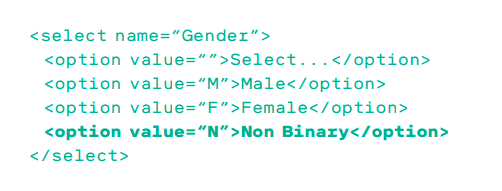Software can do better than ‘male,’ ‘female,’ and ‘other’
For transgender and nonbinary people like me, a society organized into only male" and female" makes us feel excluded. And it's something that happens frequently, especially online.
Take Gmail. There are three gender options when you register. If you choose other," you can write in any gender identity. But first you must choose how you'd like Google to refer to you-as male," female," or other."
Why something as dehumanizing as other"? Even a choice of the three most popular-he," she," and they"-would be reasonable. From a coding perspective, it would be quite simple to update the dropdown language.
It should not be difficult for companies to improve gender inclusivity on existing forms. Providing additional options often requires just changing or adding a few lines of code. Here's what it would look like to add a third gender category in PHP, which is used to program many web forms:

Of course, not all software is easy to update. That's why it's important for developers to create an inclusive program during the design stage, so that gender-diverse users can feel welcome at launch.
Though a minority, trans people are still a large demographic for software. According to estimates, there are over 1.4 million transgender adults in the US-around twice the population of Alaska. How is it that we accept one of the least populated states as the second option in an alphabetized menu of dozens of options, but find it inconvenient to add a few more genders?
Female" and male" should be at the top of the list; 99.5% of the population shouldn't have to scroll excessively to find their gender. As a trans person, I'm simply asking that developers include options for everyone who uses their software. As a developer, I know that's not too big an ask.
Everett Franchuk is a web developer and writer based in Winnipeg, Manitoba.